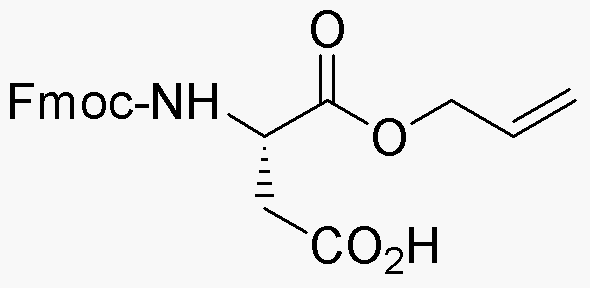Fmoc-L-aspartic acid a-allyl ester is widely utilized in research focused on:
- Peptide Synthesis: This compound is commonly used as a building block in the synthesis of peptides, particularly in solid-phase peptide synthesis, due to its protective Fmoc group that allows for selective deprotection.
- Drug Development: It plays a crucial role in the development of peptide-based drugs, facilitating the creation of compounds with enhanced bioactivity and stability, which is vital for pharmaceutical applications.
- Bioconjugation: The allyl ester functionality enables efficient bioconjugation reactions, making it valuable in the creation of targeted drug delivery systems and diagnostic agents in the biomedical field.
- Research in Neuroscience: This compound is used in studies related to neurotransmitter pathways, particularly in the synthesis of aspartate derivatives that can help in understanding brain functions and disorders.
- Polymer Chemistry: It is utilized in the development of novel polymers with specific functionalities, which can be applied in various industries, including materials science and nanotechnology.
General Information
Properties
Safety and Regulations
Applications
Fmoc-L-aspartic acid a-allyl ester is widely utilized in research focused on:
- Peptide Synthesis: This compound is commonly used as a building block in the synthesis of peptides, particularly in solid-phase peptide synthesis, due to its protective Fmoc group that allows for selective deprotection.
- Drug Development: It plays a crucial role in the development of peptide-based drugs, facilitating the creation of compounds with enhanced bioactivity and stability, which is vital for pharmaceutical applications.
- Bioconjugation: The allyl ester functionality enables efficient bioconjugation reactions, making it valuable in the creation of targeted drug delivery systems and diagnostic agents in the biomedical field.
- Research in Neuroscience: This compound is used in studies related to neurotransmitter pathways, particularly in the synthesis of aspartate derivatives that can help in understanding brain functions and disorders.
- Polymer Chemistry: It is utilized in the development of novel polymers with specific functionalities, which can be applied in various industries, including materials science and nanotechnology.
Documents
Safety Data Sheets (SDS)
The SDS provides comprehensive safety information on handling, storage, and disposal of the product.
Product Specification (PS)
The PS provides a comprehensive breakdown of the product’s properties, including chemical composition, physical state, purity, and storage requirements. It also details acceptable quality ranges and the product's intended applications.
Certificates of Analysis (COA)
Search for Certificates of Analysis (COA) by entering the products Lot Number. Lot and Batch Numbers can be found on a product’s label following the words ‘Lot’ or ‘Batch’.
Número de catálogo
Número de lote/lote
Certificates Of Origin (COO)
This COO confirms the country where the product was manufactured, and also details the materials and components used in it and whether it is derived from natural, synthetic, or other specific sources. This certificate may be required for customs, trade, and regulatory compliance.
Número de catálogo
Número de lote/lote
Safety Data Sheets (SDS)
The SDS provides comprehensive safety information on handling, storage, and disposal of the product.
DownloadProduct Specification (PS)
The PS provides a comprehensive breakdown of the product’s properties, including chemical composition, physical state, purity, and storage requirements. It also details acceptable quality ranges and the product's intended applications.
DownloadCertificates of Analysis (COA)
Search for Certificates of Analysis (COA) by entering the products Lot Number. Lot and Batch Numbers can be found on a product’s label following the words ‘Lot’ or ‘Batch’.
Número de catálogo
Número de lote/lote
Certificates Of Origin (COO)
This COO confirms the country where the product was manufactured, and also details the materials and components used in it and whether it is derived from natural, synthetic, or other specific sources. This certificate may be required for customs, trade, and regulatory compliance.


